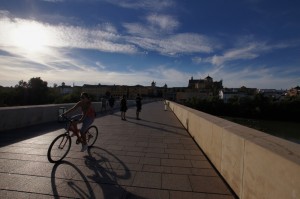“Goin’ places that I’ve never been
Seein’ things that I may never see again…”
In the spirit of Willy Nelson we are back touring.
This time it’s a shortish trip from our temporary home in Barcelona to Granada, the Sierra Nevada and Cordoba and beyond.
Our excuse was to drive Hayden to Granada, so he could spend some time there with Andrea and then bring them both back to Barcelona.
Granada is Andrea’s birth place so she was our guide, and a very good one at that.
We wandered the streets, enjoyed the tapas, which is free here, and visited the tourist attractions.
Granada is a beautiful city with a huge Moorish influence.
This is best experienced in the Alhambra Palace that proudly stands guard, high on a hill, overlooking the city.
The evidence of Granada’s Arabic and Muslim past also affects your other senses.
You can smell the spice bazaars all over the city and shisha pipes are still found in some tea houses.
The Alhambra is the most popular tourist attraction in Spain, with over 8,000 visitors a day during the high season.
It was the high season so we had to book days in advance to get an entry time, in the late afternoon, when the sun had lost some of its sting.
The Alhambra was built during the middle of the 10th century by the Berber ruler Badis ben Habus.
After the conquest by the Catholic Kings in 1492 some parts were used by the Christian rulers. Then in 1527 The Palace of Charles V, Holy Roman Emperor was built into the centre of the Alhambra.
The sight of a Spanish Renaissance palace in the middle of the Nasrid fortifications is a little incongruous, but that’s part of the charm of the Alhambra.
After the heat and history of Granada we headed into the Sierra Nevada, via the Cabo de Gata, the largest terrestrial-maritime reserve in the European Western Mediterranean Sea.
However we stayed on land, so there wasn’t much to see there, except the sea.
We then travelled north, to the southern side of the Sierra Nevada, and the small village of Capileira.
This is the highest of three villages that cling to a steep mountain side.
Tourists and Spaniards alike come to these parts for walking, mountain bike riding and Flamenco dance lessons.
We opted for the walking, and at the suggestion of the hotel, did the 7.5 km Peña del Angel track. This gave us the opportunity to see the villages from higher up the mountain and also view the panorama that sweeps down the valley and out to the Mediterranean.
Apparently on a clear winter’s day you can see Morocco.
From the mountains we headed north again to the ancient city of Cordoba. There we visited the amazing Cathedral of Cordoba or as the locals call it Mezquita-Catedral, as it’s both a church and a mosque
Originally the site was a pagan temple then the Visigothic Basilica of San Vicente and in 785 the conquering Moors built the mosque.
When the Catholic Kings reclaimed Spain it became a Christian church again and later a Catholic Cathedral was inserted into the middle of the mosque structure. Even the minaret had a bell tower built around it.
On the way back to Granada we visited the historic cities of Baeza and Úbeda, both surrounded by hills of olive groves.
These cities are World Heritage Sites, built in a style known as Civic Renaissance. There is also evidence of Roman, Moorish, Romanesque and Gothic styles but it’s the beautifully preserved Renaissance buildings that this area is famous for.
The halcyon years for Baeza and Úbeda were during the 16th Century, as the 17th Century brought hard times and civic construction halted.
Because of this economic down turn, no new building were constructed, thus saving the Renaissance buildings from being plundered for building materials.
It was then back to Barcelona for a few weeks, so we could plan our next road trip.










